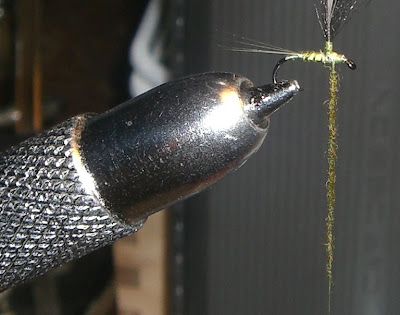The coming season will see a continuation of small fly fishing. It's worth highlighting that ultra-light fishing does not necessarily demand small flies. But, in the interest of a balanced approach and immaculate aesthetic appeal, this is how I get my kicks.
As far as fishing goes (as opposed to tying for the sake of tying), I've got a hunch that #26 flies may be the smallest practical size to tie. This is an entirely personal perspective, rather than a statement of fact, not least as the likes of Ed Engle tie and catch fish with #32's and a hunt around the www. will unearth other examples of fish caught on sub-26 size flies.

Roy Christie, aware of my obsession with tying small/tiny flies provided a priceless piece of advice. He said, "Don't get too hung up on the issue of size. Tie your tiny flies exactly as you would the small flies, just smaller!" This goes far beyond stating the obvious, and demonstrates an insight that can only come with tying tiny stuff. To put this in to perspective, Roy has tied his Reverse Parachute Emerger design down to a #30. Of course, materials, and possibly tools need to be scaled down accordingly, but the basic approach is essentially the same, and you will only run in to trouble at this scale if you assume that there is some fundemental difference in process, which there isn't. So I took this advice to heart, and have now achieved a basic level of competence when tying tiny flies.
Hook: Daiichi 1110, #26
Thread: Sheer 14/0, grey
Tailing: Microfibbets, dun
Abdomen: Goose biot, olive
Wing: TMC Aero Dry Wing
Thorax: Fine, natural hare
Hackle: Whiting Midge Saddle, light dun

One last point. There is a strong, aesthetic dimension to the notion that #26 is where I bottom out. My #26 parachute Olive is the same as my #20 parachute Olive, just smaller. They share the same proportions, neat thorax, contoured wing and segmented, biot body. Until such time that I can further scale down these common traits beyond #26, and maintain aesthetic integrity, then I'll accept that #28's, #30's and #32's are just out of reach...





















